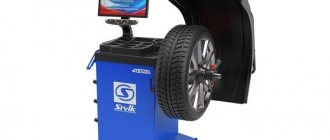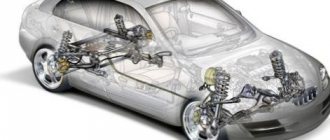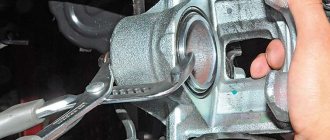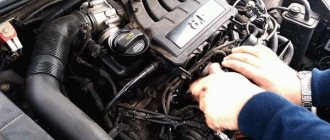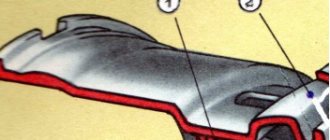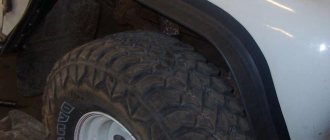Important Balancing Information
When balancing wheels, certain rules must be followed. If you ignore them, the result will noticeably worsen.
- It is necessary to remove lead weights from the rim of the disc;
- The disk is cleaned of dirt;
- It is checked how well the tire is installed on the rim;
- If there are plastic caps on the wheels, the wheel balancing is disrupted.
You can often hear the opinion from car enthusiasts that balancing does not require special attention, and the quality of car operation does not depend on it in any way. If balancing is incorrect, you may encounter the following problems:
- Tires wear unevenly;
- Individual suspension elements are subject to accelerated wear;
- The vehicle's handling is noticeably reduced;
- You can feel the steering wheel beating;
- When driving, the car may pull to the side;
- The braking distance increases noticeably;
- Road grip is reduced;
- The body begins to vibrate;
- The degree of comfort when using the car is noticeably reduced;
- Car costs increase significantly.
Causes of wheel imbalance
The appearance of imbalance is possible during normal operation of the vehicle, but it is usually preceded by the following events:
- getting the wheel into a significant hole, or driving along a road with a lot of potholes;
- hitting the curb with wheels, for example, when parking poorly;
- changing tires due to seasonality or wear of old tires;
- a large amount of dirt on the wheels, for example, after leaving the city;
- tuning a car with low-quality plastic caps with disturbed weight distribution;
- shrinkage processes that occur after running in a new tire;
- restoration operations were performed on the disc;
- There was a tire puncture.
Why do you need to do wheel balancing?
How often should you balance your wheels?
Types of wheel balancing Not all car owners know exactly why this procedure is performed. Its purpose is to ensure safety and comfort while the car is moving, to increase the service life of suspension parts, etc.
If the wheels are not balanced, then over time unnecessary centrifugal forces arise, which are transmitted first to the suspension and then to the body. These forces are multidirectional, which contributes to increased vibration and excessive loads on all elements of the car.
Moreover, the suspension experiences quite strong impacts. For example, unbalancing a 14-inch wheel by just 20 g while driving a car at 100 km/h results in suspension loads equivalent to 800 blows per minute with a 3 kg sledgehammer. Unfortunately, hardly any driver has ever thought about this fact.
No one obliges drivers to perform wheel balancing. How often to perform this operation is up to everyone to decide for themselves. But, as they say, the miser pays twice, and discs that are not balanced in a timely manner can lead to unpleasant consequences and much more expensive repairs in the future. As examples, here are some consequences that can be avoided.
- Increased tire wear and reduced service life
Increased vibration leads to periodic slipping as a result of uneven adhesion of the tires to the road while driving. This slippage, in turn, leads to rapid wear of the treads. As a result of increased wear, tires need to be replaced much more frequently. This is also reflected in financial costs.
Reduced driving safety
Centrifugal forces arising in the wheels are almost always directed in different directions at one point in time. It is difficult to imagine the behavior of a car when, on a flat roadway, one of the two front wheels suddenly jumps up, and the other at the same time makes a jump down.
It must be taken into account that centrifugal forces can act in any direction in the plane of rotation of the wheel, and not just up or down. Moreover, during the movement, this direction changes with each meter traveled due to the aforementioned slipping, which on each wheel will give its own angle of displacement. In other words, on all four wheels, as a result of imbalance, centrifugal forces arise, directed in different directions, and this direction constantly changes to an angle different for each wheel.
It is easy to guess that such phenomena make the car difficult to drive. Loss of control will sometimes produce unpredictable results, and the effect of slipping will significantly increase the braking distance. In the worst case, this will lead to an accident.
Experienced drivers may argue that their many years of driving without balancing does not affect traffic safety in any way. Here we can only talk about luck, when for several years the driver has never had to get into an extreme situation. But no one is immune from bad luck. In any case, a car is a source of increased danger. And there is absolutely no point in making this danger even higher.
Increased wear of suspension elements
Constantly present vibration also negatively affects the load-bearing elements of the suspension - they wear out very quickly. One of the first to deteriorate is the wheel bearings, which in some cases can completely collapse.
Vibration transmission to the steering wheel
Vibration causes inconvenience to the driver when driving and increases fatigue.
So, the listed phenomena are more than enough reason to do balancing in a timely manner.
Signs that your wheels need to be balanced
- When driving at speed, noise appeared, this was especially noticeable at speeds above 100 km/h. The car began to drift away from its straight path.
- There were unpleasant vibrations on the steering wheel, which increased when accelerating.
- The tread depth varies in different areas, or uneven wear is noticeable on at least one of the wheels. Very often, due to imbalance on the front wheels, the edges of the tires are eaten away.
Before we consider the standard wheel balancing technology, let’s get acquainted with the types of imbalance.
Static imbalance
It occurs due to the fact that the center of gravity shifts some distance from the axis of rotation. That is, there is an uneven placement of weight around the circumference of the wheel, as a result of which the axes of rotation and inertia become parallel.
In order to check for static imbalance, just hang up the car wheel and spin it by hand. When the wheel stops spinning, its lowest point will be the heaviest place. For reliability, the experiment must be repeated several times; if the wheel stops in the same position, this indicates the presence of a static imbalance.
Dynamic imbalance
Basic rules for good wheel balancing
Why the steering wheel pulls to the left or right - main reasons
As with any technology or procedure, there is a certain list of rules or advice, following which you can achieve a better result. Balancing car wheels is no exception, since this process uses the laws of physics, which means it is better to adhere to the rules.
- Before you start balancing your car wheels, make sure that the wheel geometry is correct, otherwise the whole process will be pointless;
- The weight of the weight for balancing a wheel with normal geometry should not exceed 60 grams. If a weight of greater mass is required, then it is worth checking the geometry of the disk, the correct assembly of the disk and tire, and the wear of the tire;
- The permissible deviation when re-balancing a car wheel should be no more than 5 grams. If the tire was removed from the balancing machine and then returned to it again, then this should be the maximum difference, no more;
- The larger the wheel, the stronger and more reliable it must be installed on the axis of the balancing machine, otherwise it will affect the quality of balancing;
- The assembly of the disk and tire is individual for each wheel, so a slight deviation is allowed on each side of the wheel, weighing 10 grams;
- Before balancing, the car wheels, disk and tire must be cleaned of dust, dirt and other parts in the tread. Such factors greatly influence the correct balancing of wheels;
- The tire must be put on correctly and on the side of the rim (most often this concerns the procedure for changing a car’s shoes from summer to winter tires). Once installed on the car, the tire will fall into place almost immediately, but the balancing will be disrupted;
- Plastic wheel caps can play a significant role in tire imbalance; most often, problems arise with low-quality hubcaps. If an imbalance appears, first double-check that the hubcaps are installed correctly and only then proceed with balancing the car’s wheels.
As you can see, the procedure for balancing car wheels is not that complicated, but at home, without special equipment, it is almost impossible to do balancing. It is best to have your wheels balanced at trusted service stations, or ask your friends where they had this procedure done. An inexperienced specialist will only worsen the imbalance rather than eliminate it.
If the steering wheel wobbles or the car body vibrates, do not delay or delay wheel balancing, otherwise you will have to pay ten times more on damaged suspension or car body parts.
Video review of proper wheel balancing:
Some tips for improving wheel balancing
To check the accuracy of the tire mounting procedure, after it has been carried out, you can remove the wheel from the balancing stand and then put it back on. Repeated diagnostics will certainly show the presence of an imbalance. For wheels made using light alloy casting technology, a discrepancy of 3 grams per side is acceptable. In the case of steel stamping, the plus or minus can reach five grams.
Some tire centers have special installations that help with “finishing” balancing. It is in no way an alternative to the procedure carried out on classic stands, but serves as an important addition with which you can determine the static imbalance of not only the wheel, but also the entire assembly consisting of wheels, hub and brake disc. The maximum weight of weights used during “finishing” balancing should not exceed 15 grams.
Do I need to balance wheels if I don't change rims?
How to determine brake disc wear
When wondering how often wheel balancing should be done, many people wonder whether it needs to be done at all when driving on the same rims. The answer will be clear: when changing tires every season from summer to winter and back, such an operation is necessary. But is it worth balancing the wheels if you change a complete set of wheels every season?
First of all, you should refer to the included vehicle instructions. As a rule, it recommends balancing after reaching 10,000-15,000 km. If less distance is traveled in one season, then there is no need to perform balancing, except for some cases described below.
But it’s one thing to follow the instructions, and another thing to watch the actual behavior of the car. Namely, it is worth monitoring the steering wheel beat. If it is not there, there is no need to balance the rims. The rear axle's runout is reflected less strongly on the steering wheel, although it suffers less frequently than the front axle. However, a significant imbalance will be noticeable in any case.
When replacing wheels yourself, it is recommended to do the following twice a year. You need to drive on new tires for a couple of days - during this time, deformations in the tires that occurred during storage will be eliminated. If there are no vibrations during driving at all speeds used, balancing does not need to be done.
The need for balancing arises in the following situations:
- mileage during the season exceeded 15,000 km;
- after another balancing, the car drove with the same wheel over a deep pothole at high speed;
- in the previous season, vibration was noted, but balancing was not carried out;
- The car does not have an ABS system, and skidding braking on asphalt is often used;
- The car is driven by a novice driver who is not yet able to sense wheel imbalance.
How to balance car wheels
Car wheel balancing is carried out using special balancing machines that can track the center of gravity. The basis of such a machine can be either a primitive computer or an entire system with laser sensors and a variety of measuring mechanisms. Such a machine automatically determines the location of the deviation and indicates where the balancing weight needs to be installed.
Depending on the type of disk, the type of weight for balancing the wheels will also change; for steel disks with a special fastening bracket, for alloy wheels there are special weights that fit on the inside of the rim. The weights themselves are made of zinc or, more often, lead, but as technology developed, steel weights also appeared. The weight of the installed weight depends on the measure of imbalance; for alloy wheels, weights from 5 to 60 grams are available in increments of 5 grams. For steel wheels, these frames range from 5 to 100 grams, also in increments of 5 grams. In any case, such weights are installed when balancing car wheels.
The greater the weight required to install the weight, the more likely it becomes that you need to check the geometry of the disk or the correctness of its assembly, whether the tread is directed correctly. Stamped weights are installed on stamped or otherwise steel disks; they are attached to the edge of the disk due to padding between the disk and the tire; this type of installation during balancing is where their name comes from.
For light alloy wheels, such weights are not suitable for balancing; firstly, they will ruin the entire appearance, and secondly, they can easily damage the disk. Usually, special weights are used for such balancing; they are installed on the inside of the disk, they are also placed on the edge of the disk, such weights are classified as padded weights, but they differ in external structure. More often they put self-adhesive weights on an adhesive base, hence the name - Velcro. The convenience of Velcro is that they are easy to install and are almost invisible after balancing. The appearance of Velcro, if noticeable, is many times more attractive than padded weights. But for such weights the surface must be perfectly flat, without chipping or peeling of the paint material.
So where does the process of balancing car wheels begin? In any case, regardless of the make, model of the car or the characteristics of the rims, they must be removed from the car. It is often recommended to remove tires one by one: according to technology, remove, balance, install, remove the next wheel - they go around the car.
Further, the entire process depends on the qualifications of the specialist who is balancing the wheels and on the equipment itself on which the procedure will be carried out, but 90% depends on the specialist. If the service station works on modern equipment, then the specialist himself will check for faults in the tire and wash it from dirt on a special machine. To simulate a car hub during balancing, there is a special metal plate. Depending on the number of holes in the disk, the plate is selected accordingly.
Having put the metal plate on the disk and carefully tightened the nuts, the specialist goes to the machine to begin the process of balancing the car wheels. Depending on the machine, the process for determining unevenness may vary. The most common balancing machine will determine the points of imbalance and show on which side and what weight the weight needs to be installed. If a balancing machine with laser sensors is used, then the system will show all the shortcomings, including the geometry of the disk, the disk and the tire separately, but naturally the cost of balancing the car wheels will be higher.
Having determined the location of the imbalance, the specialist begins to install weights, stuffing or gluing them onto the disk. After filling the weights, the procedure for checking for imbalance is checked again and, if necessary, the weights are replaced or new ones are added. In such a cycle, the procedure for balancing the wheels of the car, determining the imbalance and installing weights is repeated until the imbalance becomes zero or close to zero.
It is possible that the disc may lose its geometry and will have to be rolled, only then proceed to balancing the car wheels. Upon completion of all the necessary balancing stages, the tire is removed from the machine axle, then the specialist removes the metal plate from the rim and gives the tire for installation on the car. According to the advice of experienced drivers, wheel balancing should be done in pairs. If you decide to balance one of the front wheels, then be sure to balance the second front wheel, even if there is no reason to do so. It never hurts to play it safe and check.
Is it necessary to do balancing when changing wheels on rims?
When replacing tires on cast or stamped wheels, balancing is required. This is justified by the disturbed weight distribution of the tire and disk itself. When leaving the assembly line, products have errors that can disrupt the ideal symmetry of the axis of rotation. The consequence of the effect is rapid wear of the chassis and vibration in the body or steering wheel.
If the tire is not beaded, the procedure is not necessary, but recommended. During operation, the weights may become dislodged, and the possibility of the tire itself rotating is also not ignored.
Thus, tires must be serviced every time the wheels are handled.
Is it necessary to have wheels balanced every season?
When installing a replacement set of tires or wheel assemblies after storage, rebalancing is critical. This requirement is especially relevant when changing tires on one set of wheels. Each slope has its own weight distribution. For example, a winter studded model will differ significantly from the summer version. If it is installed in place of an old tire, the weights will be placed in the wrong places, causing severe shaking or vibration.
Thus, the annual transfer from winter to summer and vice versa is accompanied by the mandatory delivery of wheels to a special machine.
Do new tires need balancing?
Each tire leaves the factory with balance flaws. At the same time, models from trusted brands may have a greater error than budget-type options. When such a tire is placed on a wheel rim, the disproportionality is transferred to the product assembly, which guarantees runout in the suspension or vibration in the steering mechanism.
Experienced motorists, when purchasing a new set of tires, must have all wheels balanced. In this case, old weights or marks are completely removed from the rims.
Does it make sense to balance the rear wheels?
Correct weight distribution of the ramps or discs is a prerequisite for adequate suspension performance. Improperly balanced wheels greatly damage the car, regardless of the axis of location.
Why do you need to balance car wheels?
A completely fair and logical question. It would seem that you “put on” tires and drive a car for your own pleasure. In fact, not everything is as simple as it seems to many. Balancing a car wheel is an important procedure that directly affects traffic safety.
The procedure for balancing car wheels is performed in the following cases:
1. Replacing summer tires with winter tires or in reverse order. The rims remain the same, but the tires change. Driving on summer tires in winter is prohibited by law in many countries around the world.
This will definitely interest you Caring for a leather car interior
2.Frequently falling into a hole or hitting other obstacles can lead to wheel imbalance. Often the force of the impact turns out to be so impressive that the discs have to be replaced due to their damage.
3. Experts recommend balancing vehicle wheels after 20 thousand kilometers. The car does not always move on a well-maintained road surface. The presence of holes, potholes and other road surface defects negatively affects wheel balancing.
4. If the rubber surface is damaged, it is dismantled and repaired. It is necessary to balance the wheels after such intervention.
5.Long trips over distances of more than 2 thousand kilometers require a mandatory wheel balancing check for safety reasons.
When to do wheel balancing and wheel alignment
In general cases, wheel alignment and wheel balancing is necessary every 7000-8000 km. This is justified by the usual concern for the car and travel safety. Also, reasons for traveling to a service station may be work related issues.
- changing car tires;
- aggressive driving with slipping;
- falling into a deep hole at high speed;
- installation of new disks.
- routine diagnostics;
- serious impacts to the suspension;
- chassis repair;
- visual damage to tires (wear on one side).
Additionally, a broken camber can disrupt tire calibrations. If the wheels are at an angle, one part of the rubber wears out more, which invariably leads to a violation of weight distribution.
Is it possible to balance the wheels yourself?
Now that we have figured out what wheel balancing is, why this procedure is needed and how it is performed in special services, it’s time to talk about whether it can be done independently.
Nothing is impossible, especially if the situation does not allow you to contact a tire shop. Of course, it will not be possible to achieve high balance indicators without special equipment, but it is quite possible to roughly adjust it.
Do-it-yourself wheel balancing is carried out using the same weights that are used in the service. And preference here should be given to printed ones. They are freely sold in any auto store or car market.
The only tools you will need are a jack, a wrench to unscrew the hub nut, and a small hammer. Do-it-yourself wheel balancing involves carrying out all activities without removing the wheel from the hub.
Using a jack, we lift one side of the car where the wheel with suspected imbalance is located. We turn off the gear if this wheel is one of the drive wheels. Undo the cotter pin and slightly loosen the hub mounting nut.
Next, carefully inspect the tire for adhered dirt or stones stuck in the tread. All this needs to be removed. If there are old weights on the disk, they also need to be removed.
It is advisable that the tire pressure corresponds to the recommended value.
Spin the wheel counterclockwise and wait until it stops. We mark its top point with chalk. Now rotate the wheel to the right and mark the top position again. Between these marks is the easiest part of the wheel. Opposite each mark, use a hammer to place weights weighing 30 g.
Next, turn the wheel in any direction. After stopping, the weights should be at the bottom. This is the lowest balancing point. Now we turn the wheel and shift the weights, moving them apart from each other until the wheel stops in different positions. We perform the same procedure with other wheels.
Do-it-yourself wheel balancing
Hello, dear readers and visitors of the Avtogid.ru blog. Today in the article you will learn how to balance car wheels with your own hands. Of course, you can object and say that why carry out the steps to balance the wheels of your car yourself if you can contact a tire shop. These objections are partly correct, but if you look at it on the other hand, you always want to learn more new, interesting and useful information.
It’s nice to complete any actions on your own without involving outside help. Do-it-yourself wheel balancing, among other things, is an excellent opportunity to save on vehicle operation. In principle, if you take everything apart in detail, it won’t take much time to balance your car’s wheels. The most important thing is to overcome your own laziness and fatigue. Therefore, you should not balance wheels on weekdays after work, the efficiency will be zero and the quality will suffer first of all. It is better to choose a day off for this and calmly complete the work without haste or hassle.
How to do wheel balancing yourself
Some users do not know that you can balance your wheels yourself at home. The procedure can be applied to conventional stampings and castings without modification.
Motorists use two methods.
Without removing the wheel.
The essence of the process is to mount the weights in the right places. The sequence is done like this.
- Raise the desired wheel using a jack.
- Completely clean it of foreign stones and dirt.
- Prepare weights weighing from 10 to 50 grams.
- Turn the disk against the machine's direction and, after it stops, mark the highest point.
- Repeat the procedure again and apply a second mark. The middle of the gap between the risks will be the easiest part.
- Next, you need to install weights on the disk. The goal is to have the lightest side on the bottom.
- After this, a static balance is selected. The installed weights are moved 2-3 cm from the center and the wheel is rotated in the direction of travel.
- After stopping, you need to spin the tire again. If necessary, the loads are moved further apart. The goal is to ensure that the disc stops in a different position each time.
With the wheel removed from the car.
The essence of the procedure is to correctly hang the tire on the rim using a special cone. The rotating device was popular during the USSR, when there was no abundance of service stations.
Here's how to properly balance your wheels.
- Secure the cone strictly in the center of the hub.
- With the reverse side of the tool, place it on a stump or brick in a vertical position (the wheel will be horizontal).
- Place a weight on the part of the rim that is higher than the rest.
- Pump the tire slightly with your hand and wait until it stops.
- If necessary, add more weights.
The driver is required to ensure that the wheel is positioned strictly horizontally.
You can watch the video on how to do balancing at home. You can also use special granules to balance wheels. The products are poured into the tire and independently distributed throughout the cavity. The service life of the product is equal to the operating time of the tire itself. However, the method did not take root in the Russian Federation and CIS countries. The high price has its effect.
It is mandatory to take into account that for a passenger car the maximum weight of cargo on one wheel with a new tire should not exceed 60 grams. Otherwise, this is a serious reason to return the product to the store, since this violates GOST.
Do I need to wash wheels before balancing?
Before directly calibrating the wheels, it is imperative to wash them thoroughly. When the disc hits the machine, it must be perfectly clean. Small pebbles stuck in the tread and dirt affect the accuracy of the device readings. The rule is relevant for all sizes of wheels, regardless of whether it is a Gazelle or a Porsche - 100% must be washed.
How often should balancing be done?
According to the rules, balancing is carried out every 5000 km. In addition, balancing is carried out after a number of events:
After every tire change: it doesn’t matter whether it’s seasonal or not. When the steering wheel vibrates. When colliding with a curb. When falling into a ditch or hole.
Timely balancing provides a guarantee for the long life of the suspension and tires, so take the procedure responsibly.
Wheel balancing - causes of imbalance
Wheel balancing is the procedure of adding weights to the inner and outer parts of the rim or introducing special granules inside the tire, which, being attracted to the surface of the tire, balance the imbalance.
Unbalanced rotating masses on the wheel lead to imbalance. There is a strong deviation of the geometric center from the center of mass of the wheel. Important suspension elements gradually fail:
- Racks.
- Steering gear.
- Wheel bearings.
With a seemingly small unbalanced mass of 20 g, colossal loads are placed on a 14-inch wheel: at a speed of 100 km/h they are comparable to the blows of a 3-kilogram sledgehammer operating at a frequency of 800 blows per minute.
The suspension, shock absorber, and unbalanced wheel come into resonance. Vibrations spread throughout the body. This causes the steering wheel to wobble, making the ride uncomfortable, tiring and even dangerous. Therefore, wheel balancing is a mandatory procedure that must be included in routine maintenance.
Read more about the design of a modern suspension in the article: “MacPherson Suspension”.
Is balancing necessary?
Many people ask, why do balancing if the car behaves properly? And what happens if you don’t balance? Imagine that you are driving a car at a speed of 100 km/h and on a fourteen-inch rim you have an imbalance of approximately 20 grams. But the resulting load on the suspension is equivalent to blows from a three-kilogram hammer with a frequency of eight hundred times per minute. It's getting a little scary, isn't it?!
The result of such wear is the occurrence of tire slipping, and driving becomes unsafe. The imbalance leads to centrifugal forces appearing. With each meter of movement, the wheels randomly begin to change direction in different directions, and not at the same time. Just think what will happen to your car? Absolutely, control will be difficult, and the ending of such a trip may be sad.
As a result of the imbalance, tire wear will significantly increase, driving safety will decrease, suspension components will be destroyed, and the steering wheel will begin to vibrate. I think these reasons are quite enough to have your wheels balanced in a timely manner.
Of course, there may be car owners among you who will disagree and ask why balancing is needed, because they have been driving their car steadily for a long time and have not had any accidents. It’s just that you were very lucky that you didn’t get into a traffic accident, because a car is, first of all, a device that carries an increased danger, why increase it even more?
We recommend: Replacing front and rear brake pads on Lada Kalina
What are the dangers of wheel imbalance?
With the help of balancing, you can evenly distribute the weight of all wheel parts relative to the axis of rotation. After balancing, the center should be located on the axis of rotation. This operation must be done in order to obtain minimal vibrations of the wheel axis when it rotates.
The wheels must have equal mass in different directions of the axis of rotation. Wheel vibration can occur when there is an imbalance in the weight distribution that does not coincide with the direction of the axle. As a result of this, vibration can cause a number of consequences that will negatively affect the operation of the vehicle:
1. Deterioration of tire adhesion to the road due to transmitted vibration from the wheel. As a result, the driver may experience deterioration in vehicle controllability, as well as an increase in braking distance.
2. Rapid destruction of bearings in hubs due to increased loads on the vehicle’s suspension mechanisms. If the bearings break, the chance of losing a wheel increases, and as a result, the risk of getting into a traffic accident and further evacuation of the car with the help of a tow truck in Kolpino, which works around the clock, increases.
3. Frequent replacement of tires due to rapid wear of the tread, which occurs due to the deterioration of its technical characteristics caused by vibrational mechanical load.
4. Rapid fatigue of the motorist and increased loads when turning the steering wheel, caused by vibration transmitted from the wheels to the steering wheel.
How often should balancing be done?
To understand when your car's wheels need balancing, you should know the main reasons for contacting a tire shop to carry out this type of work.
For example, balancing weights can move out of place after a wheel falls into a hole. When you pressure wash your car, there is a chance that the glued weights will fall off. Collisions with speed bumps, curbs, manholes in yards, as well as impacts on the wheel with sudden movements disrupt the design of the wheels, and this in turn upsets the balance of forces affecting the wheel.
When driving aggressively and sportily on roads, balancing must be done after every 6-7 thousand km. According to manufacturers' recommendations, tire balancing should be carried out every 15 thousand km, but, as a rule, this occurs later than the annual tire replacement. If the driver uses an all-season vehicle, it is recommended to perform balancing once a year.
If the driver begins to notice that the steering wheel of the car has begun to vibrate even at low speeds, this may also be a reason to contact a tire repair shop. The reason for this phenomenon may be incompatibility of the wheel rims and the characteristics of the hubs. This can be identified through the wheel balancing procedure.
See further:
- How to properly tow a car using a flexible hitch (cable)
- How drivers are deceived at gas stations
- Current special equipment for big cities
- Do traffic police fines expire after a year?
- Advantages of GAZelle tow truck. Let's consider the used option
- How to replace a driver's license?
What are the types of imbalance?
During the existence of wheel balancing, experts have identified two main types of imbalance - static and dynamic.
For statistical unbalance, as a rule, the axis of rotation of the wheel and the axis of inertia are parallel. In this case, the wheel runout will be longitudinal, as a result, the center of gravity of the tire will shift to one side, and the mass of the disk will be distributed unevenly along its entire length. This imbalance is very noticeable inside the car even at low speeds, the car seems to jump, and it is impossible to grasp the steering wheel.
Dynamic imbalance is more common in cars, especially with wide profile tires, and occurs when the axis of inertia and the axis of rotation do not coincide. The imbalance itself appears when the center of gravity changes at a certain point on the disk, in which case the tire will be thrown from side to side, that is, the weight is incorrectly distributed across the width and not the height. Usually this type of imbalance, even a rough one, is noticeable at speeds above 40 km/h; the car begins to toss from side to side, and the steering wheel rattles and hits your hands.
It is possible that a tire may have both imbalances at the same time, but the situation is not so critical. This can be corrected on any balancing machine; for light alloy wheels it is recommended to use modern machines based on laser technology, then the result will be much better.
What is wheel balancing?
Wheel balancing is the procedure for preventing imbalance between wheels, rims, hubs, suspension parts and fasteners. The need for periodic operation is due to centrifugal force.
During the balancing process, the mass of the wheel is located evenly relative to its center. When the procedure is performed correctly, vibration during vehicle operation is reduced and the service life of bearings and car tires is increased.
Benefits of wheel balancing:
- Comfortable ride on roads of any type and quality.
- No unnecessary noise from car wheels.
- Increased wheel usage.
- Ease of driving at various speeds.
- Car tires wear out equally and evenly on all sides.
Wheel balancing is required for any car, regardless of the condition of the wheels, tires or the newness of the model.
Consequences of not balancing wheels:
- Frequent bearing failures.
- Steering wheel vibration during vehicle operation.
- Early and uneven wear of car tires.
- Noise in the cabin.
- Immediate shock absorber failure.
- Unsafe movement due to each wheel acquiring its own centrifugal force.
- In advanced cases, the vibration of the wheels causes the bolts to become unscrewed and the ball joint to fly out or fall off.
Do you need to balance your car wheels and how often?
So, why do you still need to regularly balance your wheels? Not everyone will be able to give a confident answer. There are quite a few reasons - to increase driving safety, extend the life of the car's chassis elements, make the driving experience more comfortable, etc. To better understand the essence, you will have to dive a little into physics. During movement, the wheel, among other things, is also affected by centrifugal force. The balanced wheel works properly. But unbalanced - no, because in this case additional centrifugal forces arise. Their presence is extremely undesirable, because they negatively affect the car’s suspension, accelerating the wear of its components. You don't have to pay any attention to this. Over time, the imbalance will worsen, and negative phenomena and malfunctions will begin to occur.
What is the risk of steering wheel beating due to improper balancing?
Steering wheel wobble if the wheels are not balanced correctly can lead to quite sad consequences: - you can forget about good handling and driving safety - the steering will gradually break down - the shock absorbers will fail - you will have to change the step bearings and other suspension parts. All this happens as a result of vibration spreading throughout the body due to wheel imbalance. It should be noted that steering wheel wobble can be caused by both poor balancing and defects in the disc and tires (damage to the cord, hernia, etc.). But we can say with almost absolute certainty that if the steering wheel wobbles at high speeds, the reason is an imbalance of the front wheel, and the car’s drive does not matter at all. Rear wheel imbalance is usually not displayed on the steering wheel.
Most often, the problem of steering wheel runout occurs after a seasonal tire change.
Many drivers do not pay any attention to how and on what equipment the wheel balancing procedure is carried out.
And this is very important. For example, the result of balancing can be reduced to zero after 200-300 km, if the tire shop did not wash the wheel well during balancing - the dirt will fall off and the wheel will again be unbalanced
Often the problem of steering wheel beating occurs due to the fact that a low-quality weight is installed. As a result, when exposed to centrifugal force, it will simply come off and the steering wheel will immediately manifest itself.
For example, the result of balancing can be reduced to zero after 200-300 km, if the tire shop did not wash the wheel well during balancing - the dirt will fall off and the wheel will again be unbalanced. Often the problem of steering wheel beating occurs due to the fact that a low-quality weight is installed. As a result, when exposed to centrifugal force, it will simply come off and the beating of the steering wheel will immediately manifest itself.
When assembling wheels, correct, high-precision balancing is a guarantee that you will be spared the problem of steering wheel beating and its unfortunate consequences
That is why special attention should be paid to such a seemingly simple procedure as wheel balancing. It is not particularly expensive, and saving on it is simply not advisable, since as a result of poor-quality, incorrect wheel balancing and, as a result, steering wheel beating, you will have to spend money on expensive repairs
Correct wheel balancing: how to recognize?
The wheel must have weights installed on both the internal and external sides. If it is impossible or does not want to install them during the disc phase, the weight is installed as close as possible to the outside (near the spokes) from the inside. Balancing with one weight is also possible, but due to its complexity it is rarely used. The weight to be hung (weights) should not exceed 60 grams on the wheel (new) and be located nearby. If the weight is greater, then the reason may be improper assembly of the wheel, as well as if the disk has defects (bent) or a packed tire.
The wheel balancing procedure is a recent one. Drivers neglect it because they do not know all the intricacies and advantages of the operation, remembering it only when the steering wheel begins to tremble and vibrate with every turn. The article talks about wheel balancing, what it is and why it needs to be done.
How does wheel imbalance occur?
Imbalance is nothing more than out-of-balance wheel alignment. For example, as we have already said, to balance wheels, tire fitters use special weights (counterweights) that align the wheels so that they rotate evenly around their own axis.
Unfortunately, very often these counterweights fly off on the road. This happens especially often after hitting another pothole or if the car hits a curb.
Another cause of imbalance is uneven tread wear. For example, if you are a fan of driving from a standstill, pressing the gas pedal to the floor and braking sharply in front of traffic lights, then with this driving style the tire tread on your car will wear out unevenly very quickly. In addition, rubber tends to wear out unevenly if you like to take corners.
Moreover, you may not even notice this uneven wear with a quick glance. But you should be aware that even minor changes to the tread when tires wear unevenly due to your driving maneuvers can affect concentricity due to the centrifugal force created as the wheel rotates. For example, at a speed of 100 km/h, an imbalance of just 10 grams turns into 2.5 kilograms per wheel.
